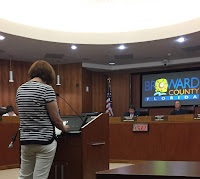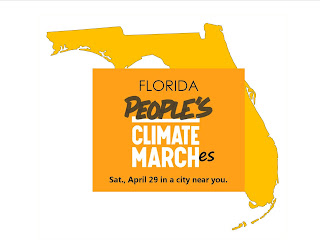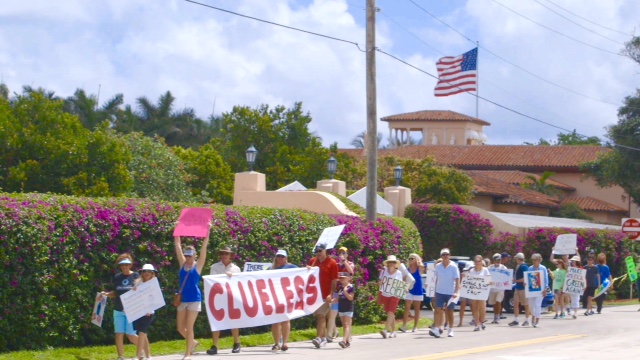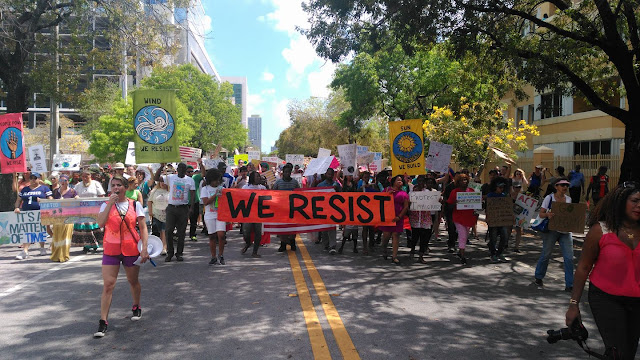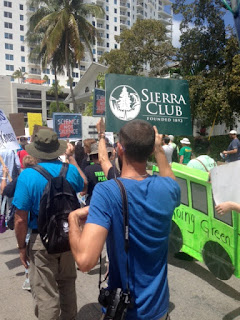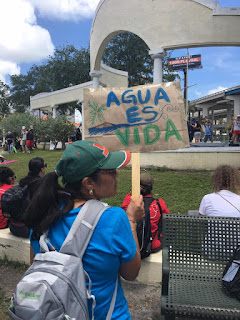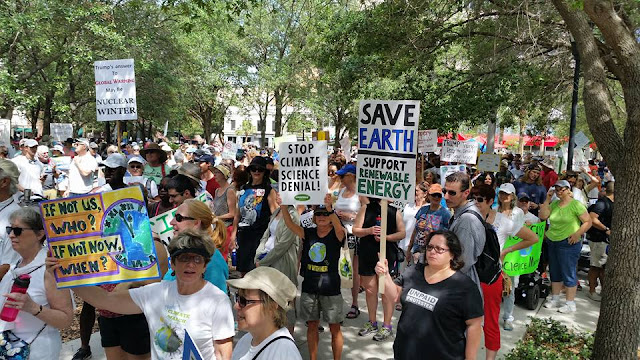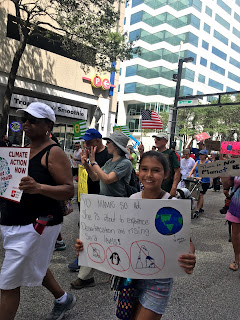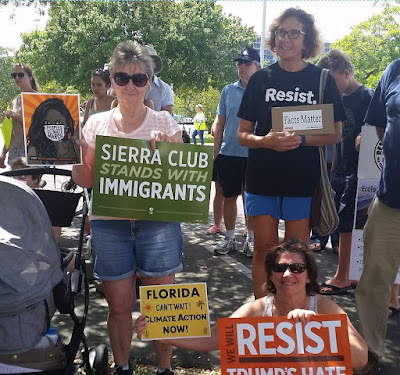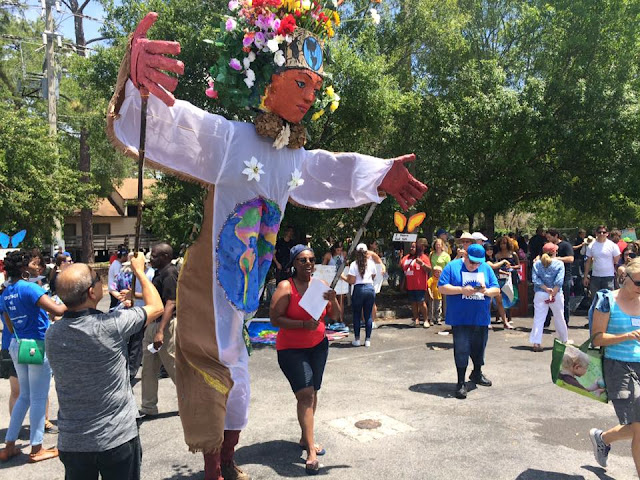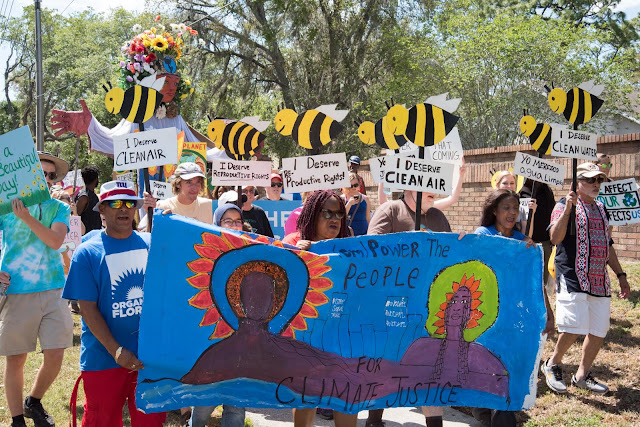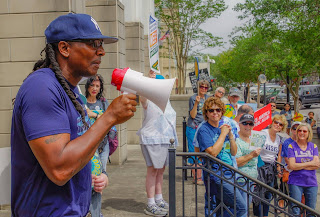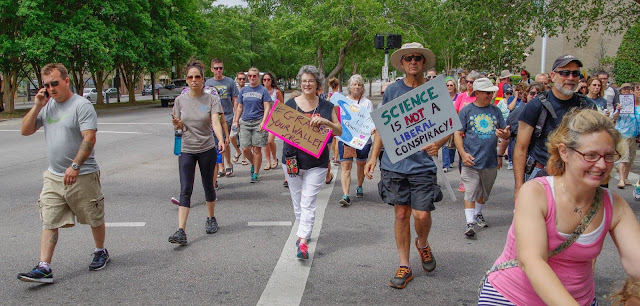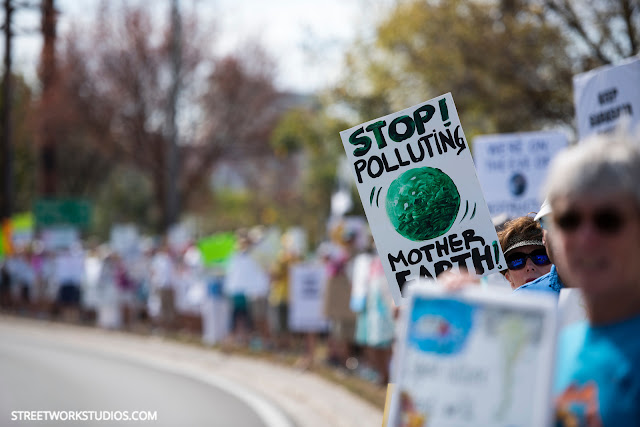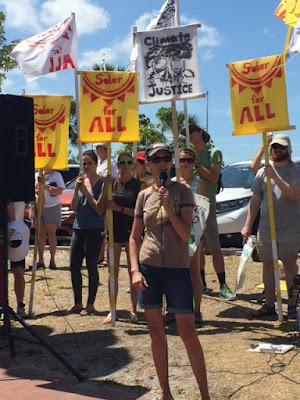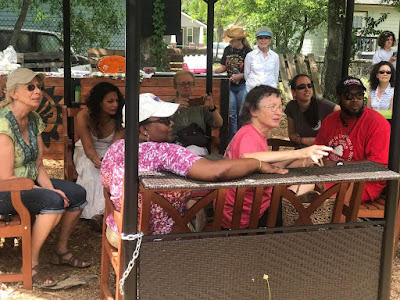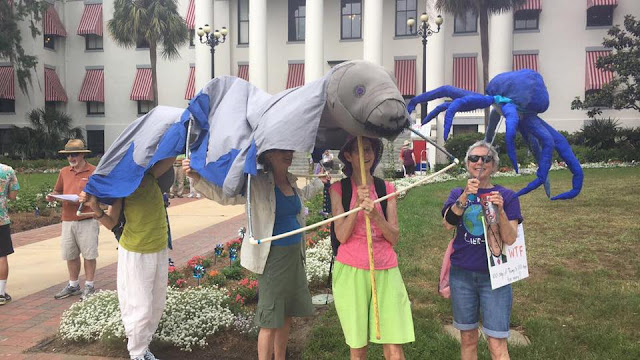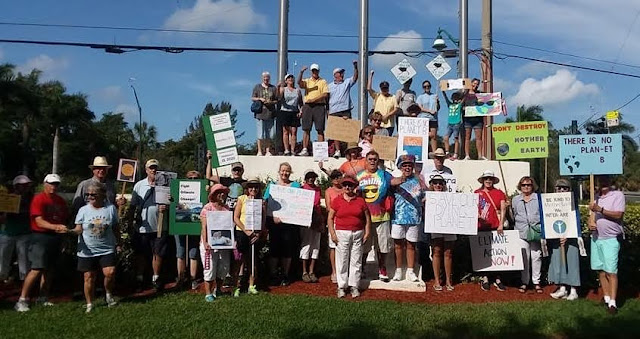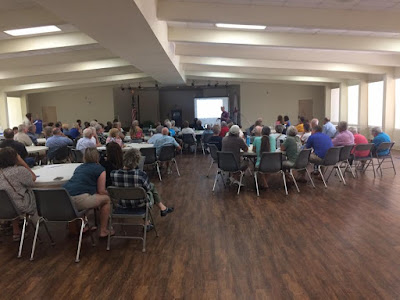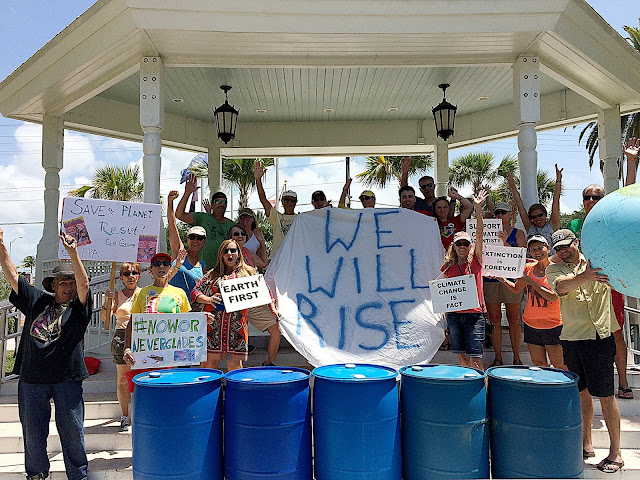 |
| Tour participants at St. Pete Eco-Village included Gina Driscoll, 5th from the left, who this month replaces Karl Nurse on St. Petersburg City Council. All photos by Bryan Blackford for St. Pete Eco-Village |
Nearly 50 participants got an inside
look at how local homeowners and businesses are using solar energy and energy
efficiency to save money and help tackle climate change during the November 11 2nd
Annual 100% St. Pete Solar Tour.
“Our goal is to present an interactive and engaging experience
that will inspire people to take action,” said Chris Kenrick, Co-Director of
St. Pete EcoVillage, a non-profit sustainability education center and community
garden located in an economically depressed area in the heart of St.
Petersburg’s urban corridor. “Just looking at solar panels on people’s houses
would be boring. So we made this more of a storytelling tour that demonstrated
very different people and lifestyles.”
For example, the homes ranged in size and age from a
750-square-foot newly built home designed
 |
| Planet Fitness fitness center with solar panels on canopy shading its entrance. |
for sustainability to a two-story,
1,800-square-foot house nearly a century old. The commercial examples included
the 20,000-square-foot Planet Fitness renovated strip center building and a
solar-covered carport on the campus of the University of South Florida St. Petersburg.
At each location, tour participants got to hear from the
homeowners and businesspeople firsthand and ask questions about costs,
return-on-investment (ROI), energy savings and challenges.
Here’s a sampling from the tour :
Early
adopter advantages
Commercial pilot Mark Ertel installed his first 20 solar panels
on the roof of his 1,600-square-foot stucco home when the local utility (now
Duke Energy) was still offering a rebate. With the rebate and federal solar tax
credit, Ertel’s out-of-pocket cost was only $2,000. “It was a no-brainer. Since
I’m saving roughly $1,000 a year on electricity bills, it was paid back in
about 2 and a half years. During the day my meter runs backwards, which means
I’m feeding electricity into the grid.”
 |
| Paul Ertel lives a clean energy life, free of coal, natural gas, and oil. |
In addition, Ertel took several energy-saving steps, including
installing Low-E windows, LED light bulbs and skylights. He also replaced his
pool pump with a variable speed pump, which he said is a “huge energy-saver …
it will run a full day for about the same amount of energy that powered one
hour with the old pump.”
In 2016 Ertel added a Chevy Volt plug-in hybrid electric vehicle
(EV) to the mix, plus six solar panels to roof of his garage. Even with
charging his EV for six months, he still got a $40 credit for the year from
Duke Energy.
Born in Germany, Ertel said he grew up being much more energy
conscious than most Americans. “To me, energy’s money. In Germany we grew up
saving energy …turning off lights when we weren’t using them. My college
already had solar panels 23 years ago,” he said. Although he’s not a member of
the Sierra Club, he said he’s definitely “environmentally conscious.”
A commercial pilot, he also thrives on the research and
technology involved in energy. “It was like a project to see if I could do it,”
he said, adding that buyers need to do their own research before purchasing
solar.
Saving
at home and business
When former St. Petersburg City Councilman Karl Nurse and his
wife bought their 1926 home in Old Southeast St. Petersburg 25 years ago they
“started at the beginning” by adding attic insulation. Since then they’ve added
Low-E film to their 25 windows, a natural gas tankless water heater, more
energy efficient lightbulbs and a programmable smart thermostat. The
thermostat, which enables him to save about 15% on power, “has a pretty
tremendous payback,” said Nurse, who now serves on Suncoast Sierra’s executive
committee (ExCom).
About five years ago, Nurse installed solar panels on the back
portion of his roof, preserving the aesthetics of the home’s distinct Florida
Craftsman style on the front. Combined with their energy-saving measures, the
solar reduces his family’s electricity bill by about 70%, he said.
 |
| Karl Nurse shows how to bring clean energy to an old house. |
Based on the positive experience at home, Nurse recently installed
solar panels on the roof of a new 3,000-square-foot building for his growing
manufacturing business, Bay Tech Label, also based in St. Petersburg. He said
he saved about 30 percent on the solar installation costs by designing the
building and roof for solar from the beginning. He estimates the solar will
have a six-year payback in energy cost savings.
Creating
a sustainable family compound
Architect Tim Rhode is transforming a small corner of St.
Petersburg into a self-sustaining family compound shared by he and his wife,
two daughters and their children. The oasis within the city includes three
homes, a workshop, small organic farm and many energy- and water-saving
features. His goal is to ultimately generate enough power, water and food to
sustain the 11 people living there.
“We’re really living in a world that can’t sustain our typical
lifestyle,” said Rhode. “So I’m trying to do what I can to minimize my family’s
impact on the environment.”
One of his biggest energy-saving moves was to downsize from a
3,600-square-foot home in old Northeast to the 750-square-foot house he built
behind his daughter’s home. “To convince my wife we could live in such a small
space, I went through and labeled the spaces in our old home that we actually
used. Then I showed her how we could provide for all those activities in this
design,” said Rhode.
He designed the home for passive cooling and heating so it uses
no additional heat or air conditioning. The solar panels on the roof generate
enough electricity for the home – with some to spare and send over to his
daughter’s home. The home also includes a 12,000-gallon cistern that collects
rainwater for use in the farm.
Valuable
takeaways for participants
Throughout the three-hour tour, participants peppered the
homeowners and tour hosts with questions touching on their biggest concerns
about going solar. Some of the key points and lessons included:
- No maintenance
required: Homeowners reported that their solar installations continued
functioning without problems or any special maintenance. At most, they said
they rinsed off the panels about once a year.
- Zero
damage from hurricanes: Despite some high winds brought by
Hurricane Irma, hosts said their panels sustained no damage. They explained
that in Florida, solar panels are required to stand up to hurricane-force
winds.
- Simple
energy efficiency measures deliver high return:
Besides solar, each home and business owner stressed that basic energy-saving
steps played a major role in their strategies to cut electricity consumption
and costs. Don’t underestimate the value of switching to LED lightbulbs, using
Low-E windows or film and other actions.
- Do your
research and ask for help: Like any home or business improvement,
owners need to double-check the claims made by solar companies. Many Florida
cities now have solar co-ops set up by Solar United Neighbors of Florida, an
initiative led by the League of Women Voters. The co-ops offer both education
and savings for homeowners interested in going solar.
Wish
you were there? Click here to get a
brief video sample of the St. Pete Solar Tour. (Video produced by Bryan Blackford
of St. Pete EcoVillage.)
Want to host a solar tour in your area? Here’s how:
A
solar tour can be a great way for local Sierra groups to promote renewable
energy and energy efficiency and increase awareness in your area. This can be
an especially effective tactic for promoting your group’s Ready for 100
campaign.
If
your group is interested in organizing a tour, here are some tips based on the
St. Pete Solar Tour:
·
Identify tour sites. Brainstorm ideas
with your partners about potential sites, preferably representing a selection residential,
business and school/government/nonprofit installations that would make
compelling examples of solar and energy efficiency at work. Aim for a variety,
from small to large and different situations, with interesting stories to tell.
·
Plan logistics. The locations need
to be within a small enough geographic area to keep the tour within 3 hours. For
example, the St. Pete tour featured 7 sites and ran like clockwork, running
from about 9 am to Noon on a Saturday. Plan to use a bus with capacity for
about 50 participants and map the stops to make an efficient route. Allow at
least 15 minutes at each stop. Over-flow participants can use their own
vehicle, but only if the bus is full, to minimize emissions.
·
Base the budget to
break even.
This shouldn’t be a fundraiser. For example, the St. Pete tour cost $10, with
an option to pay $5 more to enjoy a lovely organic garden lunch after the tour
at the St. Pete EcoVillage. With 50 participants, the event netted $100 after
expenses, according to EcoVillage Co-Director Chris Kenrick, which included a
rented school after expenses bus and driver.
·
Promote the event
widely.
Engage media to list the tour in their event directories. Line up newspaper,
blogosphere and broadcast reporters in advance to attend and cover the tour –
emphasize the event’s great visuals and opportunities to interview home and
business owners. Promote the event via email, website and social media for each
coalition partner.
These
are just the basics for your group’s leaders to consider. If you want to move
forward, reach out to your local Ready for 100 team. There’s probably a team already
active in your area.
For more info on how to organize a solar tour in 2018, and
how to connect with your local Ready for 100 campaign, contact Sierra Club FL Ready
for 100 Senior Organizing Representative Phil Compton at 727-824-8813, ext. 303
/ phil.compton@sierraclub.org.
If you’re in South Florida, contact Ready for 100 Organizing Representative Emily Gorman at our
Miami office, 305-567-0022 / emily.gorman@sierraclub.org.
Phil Compton, Senior Organizing Representative
727-824-8813, ext. 303 phil.compton@sierraclub.org
